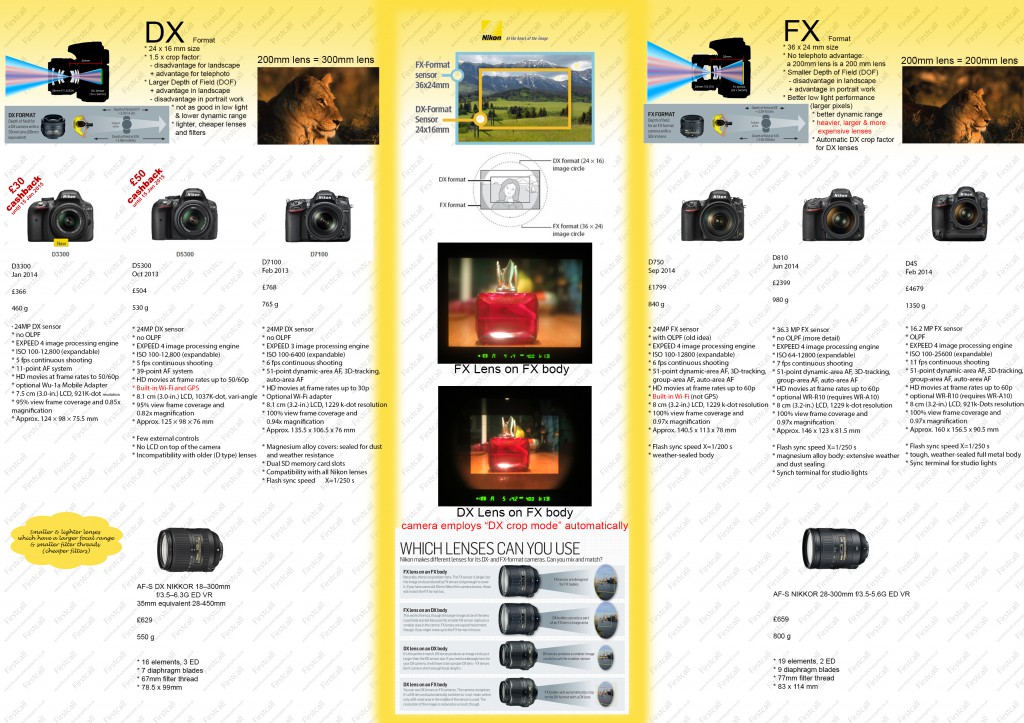What Nikon DSLR would be best for you?
Modern websites are quite frustrating; rarely do they allow you to compare more than 3 products at once. So what do you do if you want to get a general overview of what is available? There are so many different DSLRs out there now; we shall discuss digital implications of general photographic principles, like sensor format sizes, resolution, crop factors, depth of field, lenses and filters etc over the coming weeks using the example of Nikon cameras. So what should you watch out for when buying a DSLR?
- Sensor size. Do you want to use a Full Frame (FX) or the smaller APS-C (DX) size sensor?
- Image Processor Generation. Image processors get faster and smarter with each update; current Nikon DSLRs employ Expeed 4 processors.
- Time of Release. This is indicative of the technological stand the camera body will have, how light sensitive it is (ISO), what metering system is used, what Autofocus it deploys etc.
- ISO Range. Even in digital photography, light sensitivity plays a huge factor. Current Nikon DSLRs manage a broad range from ISO 100 to ISO 6400 as standard; a select few offer a stop below, quite a lot offer a step above this range. Bear in mind that these values are expandable; you can always shoot on "High" with grain and noise penalties, of course.
- Resolution. Much is being made of resolution - but the fact is, you will almost never use 24 MP and above - other than to crop it in one way or another! How often do you print posters? Exactly, most images end up as 4 x 6 in prints in albums - or even worse, as 1200 pixel width on Flicker, 900 pixel width on Facebook or a 640 pixel width image on Instagram.
- Viewfinder Frame Coverage. Admittedly this is an odd one - but if you frame your images carefully (i.e. for leading lines or deliberately excluding certain background elements), you will have unpleasant surprises if the viewfinder doesn't show you everything that will be recorded in the image, i.e. 95% frame coverage.
- Connectivity. In a connected world, it is desirable to have at least the option of Wi-Fi, if only to trigger the camera from a smart device. Sending images across to a smart device is still pretty slow (approximately 6 seconds for a full resolution image) but at least it is an option when out and about.
- HD frame rate. Virtually all DSLRs now take HD video - but pay attention to whether it is capable of the full 60 frames per second. Bear in mind that this will be merely a temporary format; 4K video is out there and it will be coming to DSLRs before long.
- Flash Synch speed. This is important for fill flash and creative lighting. If you think you would like to experiment in that area, make sure your camera body is capable of 1/250 second synch speed.
- Physical size and weight. Don't mock it - it may make the difference between taking your DSLR or leaving it at home - and making do with your camera phone.
Naturally, there are so many other factors that may influence your final choice, some of which depend on your style of shooting and type of use of the camera - and of course, the price is important too! We have compiled a general overview of what the latest Nikon DSLRs are capable of, with a few general pointers regarding the FX and DX formats (click to download full resolution):
- 8th December 2014





